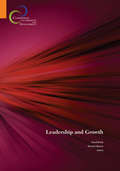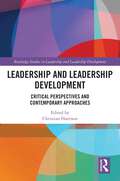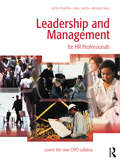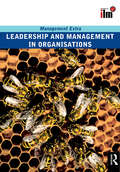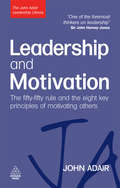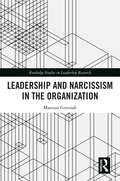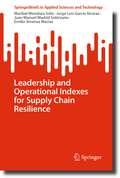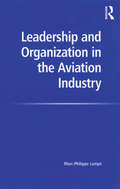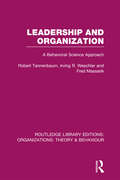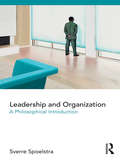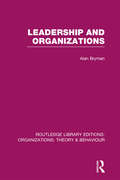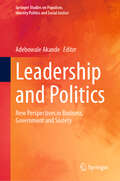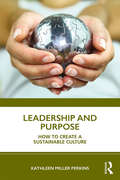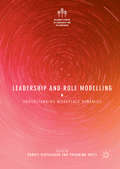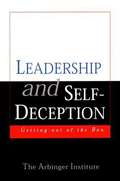- Table View
- List View
Leadership and Global Justice
by Douglas A. Hicks Thad WilliamsonWhat does global justice look like, and how can leadership help get us there? The contributors explore justice in various spheres: citizenship, the marketplace, health, education, and the environment. And they provide creative and constructive moral approaches for evaluating and promoting global justice.
Leadership and Growth
by Michael Spence David BradyDoes leadership affect economic growth and development? Is leadership an exogenous determinant or an endogenous outcome of growth and development processes? Can we differentiate between the two? Do leaders' decisions and actions vary in importance over various stages in the process, at least in successful cases? How important is choosing the right economic model? To what extent does leadership affect the explicit or implicit time horizons of policy choices? Is leadership an important determinant of inclusiveness in growth? In what ways do leaders build consensus or institutions to allow time for the economic plan to work? What challenges does economic success generate? How do successful leaders adapt to new problems such as income inequality and a rising middle class? Does the creation of new institutions play any role in solving these problems? Why do leaders often choose second best political economic compromises in economic development? This book has been prepared for the Commission on Growth and Development to evaluate the state of knowledge on the relationship between leadership and economic growth. It does not pretend to provide all the answers, but does review the evidence, identify insights and offers examples of leaders making decisions and acting in ways that enhance economic growth. It examines a variety of topics including leaders' roles in: promoting national unity, building good solid institutions, choosing innovative and localized policies, and creating political consensus for long run policy implementation. Written by prominent academics and actual policy makers, Leadership and Growth seeks to create a better understanding of the role of leadership in growth and to encourage further studies of the role of leadership in economic growth.
Leadership and History
by Walter A. FriedmanHistorians have written a lot about business leaders, especially successful ones. In fact, rags-to-riches stories have come to embody the philosophy of America itself, yet the term "business leadership" was rarely used until the early twentieth century. This chapter looks at historians who have studied the functional role of leadership and have aligned it with the early twentieth-century economist Joseph Schumpeter's definition of entrepreneurship: a creative-destructive process carried out both by individual agents and by those working in firms. (It was Schumpeter who famously described the entrepreneur as a "rogue elephant" who has the courage and chutzpah to overturn the existing order.) The author focuses on the work done at Harvard's Research Center in Entrepreneurial History-in existence only from 1948-1958, yet home to some of the most prominent scholars in sociology, economics, and history. He reviews the research of two historians, Fritz Redlich and Alfred Chandler, who use history to illuminate the phenomenon of leadership, particularly the concept of leadership as a "disruptive art." This chapter was originally published as Chapter 11 of "Handbook of Leadership Theory and Practice: A Harvard Business School Centennial Colloquium."
Leadership and Independence at the Federal Reserve
by David A. Moss Marc CampasanoPaul had opposed the Fed for decades and had offered several bills to dismantle it, dating back to 1983. As with all of his previous attempts, the 2009 bill died in committee. Although few members of Congress shared Paul's desire to eliminate the Fed, the central bank's unprecedented interventions during the 2007-2009 financial crisis provoked new sources of resistance. At a minimum, many more Americans were curious about the inner workings of the Fed, whose activities and decisions were frequently wrapped in secrecy. From its earliest days, the Fed's supporters had insisted that monetary policy had to be separated from electoral politics to prevent the manipulation of the money supply and interest rates for short-term political gain. Increasingly, however, critics questioned whether the costs of Federal Reserve independence and secrecy might outweigh the benefits. By late 2009, mounting concerns in Congress had breathed new life into one of Representative Paul's milder proposals for containing the Fed. Though his ultimate goal was to "end the Fed," Paul had also repeatedly proposed a full audit of the institution. By November 19, 2009, his latest audit bill had attracted 313 cosponsors, a record level of support, and the House Financial Services Committee was scheduled to vote that very day on whether to append a version of the proposal to a major financial reform bill that was then taking shape in Congress. If the audit provision became law, it would represent a notable change in policy, providing an unprecedented window on Fed activities and raising significant new questions about the nature of central bank independence in America.
Leadership and Leadership Development: Critical Perspectives and Contemporary Approaches (Routledge Studies in Leadership and Leadership Development)
by Christian HarrisonLeadership as a practice, and the development of leaders, has evolved significantly in recent decades, influenced by rapid changes in the business landscape, technology, social norms, and global challenges. The unprecedented disruptions brought about by crises, the increased awareness around diversity, equity, and inclusion, and the rise of new organisational models have all necessitated a rethinking of traditional leadership frameworks. At the same time, the focus on leadership development has shifted, with a greater emphasis on developing skills that foster adaptability, inclusivity, sustainability and resilience.In response to these shifts, this book provides a critical examination of leadership and leadership development, offering new insights and contemporary approaches that reflect the changing needs of organisations and societies. With contributions from leading scholars and practitioners across diverse fields, the 12 chapters in this edited volume present a rich blend of theoretical, empirical, and reflective research. It provides fresh perspectives on leadership development by exploring themes such as diversity and inclusion, sustainability, innovation and resilience.
Leadership and Lifelong Learning: Leading Change in the Twenty-First Century Organization
by John P. KotterThe key to creating and sustaining a successful twenty-first century organization is leadership-not only at the top of the hierarchy, but also throughout the enterprise. And fortunately, according to John Kotter, leaders are not born, but are made over a lifetime of learning. This chapter examines the relationship between lifelong learning, the development of leadership skills, and the capacity to succeed in the future. This chapter was originally published as Chapter 11 of "Leading Change."
Leadership and Management for HR Professionals
by Paul Smith Keith Porter Roger FaggThis is a new and completely revised edition of the successful text published in 2000 entitled Core Management. The book provides excellent coverage of the CIPD syllabus for three core areas of the CIPD syllabus.New end of chapter website links are included. The text is written in an easy-to-read style and each chapter is linked to other relevant parts of the book.
Leadership and Management in Organisations: Revised Edition (Management Extra Ser.)
by ElearnJohn Kotter of the Harvard Business School is one of a number of experts who believe that organisations are over managed and under led, at least partially because people do not appreciate the differences between management and leadership. We start this book by challenging mental models of leadership and management. Agility has become a prerequisite for organisations in a business environment that is characterised by change. Two trends in particular have been evident. First hierarchical systems of management are yielding to a “new leadership” movement which has at its core shared vision and individual empowerment in place of consistency and control. Second, leadership is no longer the preserve of those in positions in the management hierarchy. Increasingly it is dispersed through the organisation. By developing awareness of these and other influential trends, those who have a responsibility for leading and managing in some form will be better equipped to flex their style and to play the diverse roles required of the managerial leader in contemporary organisations.
Leadership and Management in Pharmacy Practice (Pharmacy Education Series)
by MD Karch Drummer Steven B. OlafOver the past years, the changing nature of pharmacy practice has caused many to realize that the practice must not only be managed, but also led. Leadership and Management in Pharmacy Practice discusses a variety of leadership and managerial issues facing pharmacists now and in the future. This second edition has been reorganized by placing leader
Leadership and Mindful
by Joan MarquesAwareness is a critical aspect of successful leadership. As a new generation of business people enter the job market, the value of perceptive individuals should be considered among the most important assets for any company to acquire. Aimed at business students preparing to enter the workforce, Leadership and Mindful Behavior provides readers with guidelines for effective and perceptive leadership. Some of the aspects to be reviewed will be the importance of both soft and hard skills; the concepts of sleepwalking and wakefulness; and mental models, respect, change, and compassion.
Leadership and Mobilization
by Robert S. Kaplan David P. NortonThe process to initiate the Balanced Scorecard management system starts with a leader creating the sense of urgency for change. The urgency can come from reversing recent underperformance, responding to a changing competitive environment, or stretching the organization to be much better than it currently is. This chapter looks at different approaches used by leaders to plant the seeds of change and to cultivate and sustain change initiatives once they've been launched.
Leadership and Motivation: The Fifty-Fifty Rule and the Eight Key Principles of Motivating Others
by John AdairJohn Adair has transformed our understanding of how leadership works with his pioneering book Not Bosses But Leaders. Here he explores the nature of motivation, individual needs and how they relate to the key tasks facing leaders and managers - good, positive motivation can create, maintain and improve the performance of any team.In Leadership and Motivation John Adair also puts forward his own theory of motivation - the fifty-fifty rule - and then identifies the eight key principles for motivating others.Motivation increases efficiency and productivity - and makes reaching targets more likely. Leadership and Motivation will stimulate your thoughts and ideas on how to inspire others, and offers you some practical ways to motivate yourself and others to achieve.
Leadership and Narcissism in the Organization (Routledge Studies in Leadership Research)
by Mateusz GrzesiakNarcissists are seen as people who could inspire others due to their strong charisma great vision and ability to convince the crowd that they possess features that others don’t. They have followers and fans, and the ability to control them. On the other hand, narcissistic leaders express a lack of empathy and high levels of aggression and show constant criticism of others while refusing feedback on their performance. Those features indicate that such leaders have a strong sense of entitlement of superiority; therefore, it is hard to work with them. In the corporate world, many individuals with narcissistic personalities are chosen as leaders of organizations or teams, which often harms their co-workers and subordinates. Very few lower-level employees have a positive perception of their narcissistic leaders or are satisfied with their job, and so there is need to measure through qualitative research based on already existing articles in a given subject the correlation between the perception of narcissistic leader and the leader evaluation method. This book gives insight into psychology and management by linking the narcissistic personality with the leadership role and with the method of evaluating a leader, along with discussing the positive or negative outcomes of their leadership. Readers will learn about the phenomenon of narcissistic individuals and leaders as well as the attributes and traits of such a person. This research monograph will be of interest to researchers, academics, and advanced students in the fields of work and organizational psychology and leadership studies.
Leadership and Operational Indexes for Supply Chain Resilience (SpringerBriefs in Applied Sciences and Technology)
by Jorge Luis García Alcaraz Maribel Mendoza Solis Juan Manuel Solórzano Emilio Jiménez MacíasThis book presents a novel approach for studying the impact of leadership styles on supply chain resilience using a combination of transactional and transformational leadership. The book consists of two main sections: The first introduces key concepts and provides a framework for understanding the research problem and methodology. The second section presents five structural equation models developed and validated using data collected from a survey of managers and engineers in the Mexican Maquiladora Industry. These models explore the relationships between key variables, such as agility, flexibility, alertness, and efficiency, and how they are affected by different leadership styles. The findings of this study suggest that a combination of transactional and transformational leadership is highly effective in enhancing resilience and achieving better results during disruptive events. Written in a clear and accessible style, this book is an essential resource for scholars, researchers, and practitioners interested in supply chain management, leadership, and resilience. It contributes to the existing literature on these topics and provides practical insights for improving supply chain performance in today's complex and dynamic business environments.
Leadership and Organization in the Aviation Industry
by Marc-Philippe LumpeLeadership and organisational structures which are not adjusted to the cultural background of the employees concerned are most likely to produce sub-optimal results (House, 2004). Therefore it is necessary to develop appropriate leadership and organisational structures in order to fully grasp the cultural environment to be encountered in the professional world. This book presents a research project that was carried out to develop leadership and organisational structures in accordance with the requirements created by different professional backgrounds within the aviation industry. The identification of the different professional cultures was undertaken using a standardised questionnaire. The development of the questionnaire was carried out with the help of the GLOBE study (House, et al., 2004), one of the most extensive research efforts ever undertaken in the field of organisational and national cultures. The main characteristic of the GLOBE study is the development of nine dimensions which serve to identify and characterise any culture. These dimensions are referred to as 'core cultural dimensions'. Using this newly developed questionnaire, it was not only possible to isolate 12 different professional cultures, but also to identify their distinguishing traits which served as the base for the subsequent development of leadership and organisational structures. The survey was complemented by open interviews served to broaden and deepen the results gained with the standardised questionnaire. The research outcomes open the door to a new and important element of cultural research, complementary to those of organisational and national cultures. Although the study was carried out in the aviation industry, the results gained also appear to be transferable to other industries due to the large variety of professions isolated within the course of the presented study and the specific nature of the aviation industry itself.
Leadership and Organization: A Behavioural Science Approach (Routledge Library Editions: Organizations)
by Robert Tannenbaum Irving Weschler Fred MassarikThis book represents a selected collection of the writings, from 1950 to 1960, of members of the Human Relations Research Group (HRRG), from UCLA. The writings are followed by independent comments and appraisal from different viewpoints, prepared by distinguished experts in management theory, group psycho-therapy and psychology and sociology.
Leadership and Organization: A Philosophical Introduction
by Sverre SpoelstraThis book is a philosophical exploration of the relationship between leadership and organization. Each chapter in the book sheds light on this relationship by exploring leadership with respect to a particular theme: charisma, authority, religion, language, authenticity, image and followership. These themes are linked to popular notions of leadership, such as transformational leadership, authentic leadership and servant leadership. Offering insight into the ways in which leadership is understood in contemporary culture, the main thesis of Leadership and Organization is that understandings of leadership today are still shaped by the figure of the charismatic leader, even though charismatic leadership itself has lost much of its appeal. The clearest expression of this paradigm is the leadership-management distinction, where the leader is someone who transcends the organization and the manager someone who resides within the organization. Drawing on a broad variety of sources in continental philosophy, the author explores the central philosophical question of how leadership can be understood in relation to organization This book provides new perspectives on leadership that will be of interest to all students, academics and practitioners who are interested in challenging their thinking about leadership. It will particularly appeal to those considering leadership studies from a critical or philosophical angle.
Leadership and Organizational Outcomes
by Engin KaradağThis book focuses on the effect of leadership on organizational outcomes and summarizes the current research findings in the field. It addresses the need for inclusive and interpretive studies in the field in order to interpret leadership literature and suggest new pathways for further studies. Appropriately, a meta-analysis approach is used by the contributors to show the big picture to the researchers by analyzing and combining the findings from different independent studies. In particular, the editors compile various studies examining the relationship between the leadership and thirteen organizational outcomes separately. The philosophy behind this book is to direct future research and practices rather than addressing the limits of current studies.
Leadership and Organizational Sustainability: The Knowledge Management Approach (Routledge Studies in Management, Organizations and Society)
by Roberto Tuda Rivas Elia Socorro Díaz Nieto David Israel Contreras MedinaThe book presents a new type of leadership focused on sustainable human development and organizational sustainability, which is based on the self-realization of the person of the leader, which means the satisfaction of their needs, according to the scale of Abraham Maslow, through integral human development in all aspects of life. Because the term "leader" appears to refer to anyone with the authority to confer a position with subordinates, the reality within organizations has shown that a leader must go further and demonstrate commitment, awareness, and concern for the common good. Which person has these characteristics? People who have had more opportunity to develop in different areas of their being, resulting in them being conceived as more educated. The qualities in a person are the basis of leadership. Education and practice are much more important than all hereditary and genetic codes. This volume explores the various ways of making explicit the dimensions of social, economic, and environmental sustainability through knowledge management that addresses the identification, collection, processing, circulation, use, exchange, and preservation of knowledge within operating systems and the context of organizations, considering issues that contribute to sustainability – human and organizational – where the leader is the main actor and the means is knowledge management.
Leadership and Organizations (Routledge Library Editions: Organizations)
by Alan BrymanIn this textbook Alan Bryman provides a detailed and critical examination of the literature on leadership in organizations, giving special recognition to the needs of students of organizational behaviour and the social psychology of organizations. After an examination of the complexity of the concept of leadership, the author describes the major approaches to the analysis of leadership in organizations, including: the idea that effective leaders have special traits; the various attempts to examine leader behaviour; normative approaches to the study of leadership; and the various theories which emphasize the importance of recognizing situational differences in understanding leadership effectiveness.
Leadership and Politics: New Perspectives in Business, Government and Society (Springer Studies on Populism, Identity Politics and Social Justice)
by Adebowale AkandeThis volume sheds light on the world of organizational politics, political leadership, and the pivotal roles played by employees and political leaders in managing diverse groups. It picks up where influential scholars like Edgar Schein, Harry Triandis, Bernard Bass, Robert House, Shalom Schwartz, and Geert Hofstede left off, providing a timely and transparent exploration of these crucial topics. In a rapidly evolving landscape, characterized by renewed interest in political skill, people management, leadership and management, diversity training, organizational culture, workplace incivility, ambivalence alliance, and career development, the book emerges as an invaluable resource, assembling a group of renowned contributors in the field, who have conducted extensive social research. It offers a comprehensive view of contemporary organizational politics, psychology at work, DEI, political skill/will, HRM, leadership effectiveness, organizational behavior and culture, relationships in the workplace and emotions in politics, favoritism, workplace incivility, ambivalent alliance, people analytics, and office politics, and competition. The book discusses the ongoing struggle between knowledge-driven scholarship and dogmatic ideology in the workplace and beyond. As organizations grapple with the challenges of today's business environment, the book therefore is an indispensable guide for scholars, consultants, and leaders committed to driving continuous improvement and navigating the complex intersection of politics and leadership in the modern workplace.
Leadership and Purpose: How to Create a Sustainable Culture
by Kathleen Miller PerkinsCompanies that have integrated a contribution to society into their business models are more likely than others to succeed for the long term. This book provides you with information, tips, and tools to assess and strengthen your company for ongoing success. Through the use of case studies, the book describes the leaders’ journeys – the mistakes they made, the successes they achieved, and the lessons they learned. Some are certified as Benefits Corporations (B Corps) because they have incorporated a clear societal purpose into their missions and they are able to demonstrate positive social impact. Others, while not certified B Corps, are at various stages in their commitments to society. The book is for leaders at many levels, including CEOs, senior leaders, and managers, as well as those without formal positions of authority but who can influence others and contribute to a sustainable culture.
Leadership and Role Modelling: Understanding Workplace Dynamics (Palgrave Studies In Leadership And Followership Ser.)
by Shruti Vidyasagar Poornima HattiThis edited volume explores the influence of role modelling as a process in the workplace; in particular, whether it can aid career development, offer psycho-social support, and provide the motivation and means to achieve goals. Chapters examine whether the dynamics of personal identification and self-belief can affect the way that role models are chosen, placing emphasis on geographical diversity and cultural aspects. By including studies of gender and followership in both American and Indian settings, the scholars and practitioners who contribute to this collection outline key aspects of role modelling, and its effect as a developmental tool in the workplace, from the perspective of the individual and organisations. This book is a valuable resource for academics interested in organisations, management, and diversity, as well as practitioners and policy-makers involved in leadership programmes, who will find its collection of both theoretical and empirical findings extremely useful.
Leadership and Self-Deception, Fourth Edition: The Secret to Transforming Relationships and Unleashing Results
by The Arbinger InstituteWith almost 3 million copies sold worldwide, this new edition of an enduring classic is the definitive guide to dramatically improve leadership effectiveness, transform personal and professional relationships, and unleash organizational results. Significantly revised throughout, this edition includes updated stories, brand new content, and a practical group discussion guide.Over two decades since first being published, Leadership and Self-Deception continues to help readers discover and overcome the persistent lies that are at the heart of the people-related dysfunction that plagues relationships and hinders organizational results. Told through an engaging story, this book reveals the ways we blind ourselves to our true motivations and unwittingly sabotage our efforts to achieve success and rebuild broken relationships. Completely rewritten throughout, this fourth edition features important updates: A broader cast of characters who resonate with a wide and diverse audience Updated stories and examples that help readers immediately apply these timeless concepts to the modern workplace An individual study and group discussion guide to facilitate personal and team discoveries Practical guides to apply the tools on a personal, team, and organization-wide levelExplore the ideas that have helped millions of people and thousands of organizations sustainably transform relationships and results.
Leadership and Self-Deception: Getting Out of the Box
by Arbinger InstituteThe "disease" of self-deception (acting in ways contrary to what one knows is right) underlies all leadership problems in today's organizations, according to the premise of this work. However well intentioned they may be, leaders who deceive themselves always end up undermining their own performance. This straightforward book explains how leaders can discover their own self-deceptions and learn how to escape destructive patterns. The authors demonstrate that breaking out of these patterns leads to improved teamwork, commitment, trust, communication, motivation, and leadership.

